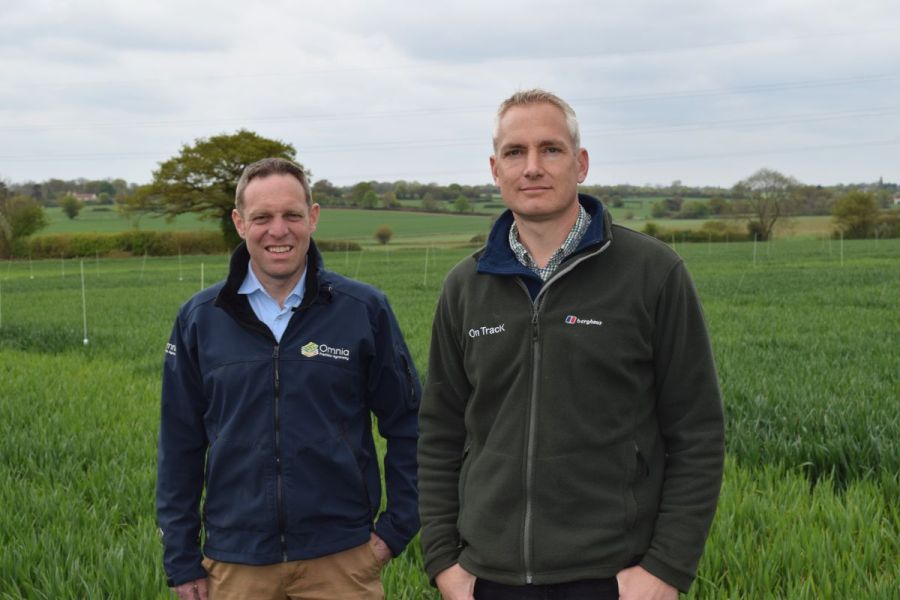Deciding how to get the most from expensive nitrogen fertiliser is at the forefront of many minds this spring. CPM talks to two growers at the cutting edge of applied farm research to see how the knowledge they’re gaining from this is influencing their approach.
“We’re massively changing the way we’re using nitrogen, tailoring it even more per field and per crop than before.”
By Paul Spackman
There’s nothing like a dramatic rise in costs to reinforce the importance of maximising input use efficiency, and nitrogen fertiliser tops the list.
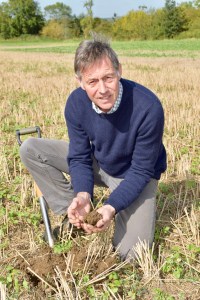
Andrew Pitts recognises that historically, nitrogen rates were beyond the economic optimum, so has reduced the total applied, favouring a “little and often” approach.
Prices may have fallen from 2022’s highs, but many growers have been left looking for cheaper alternatives, such as urea, or are reducing applications this spring. In all cases, it’s vital every last drop, granule or prill is used as efficiently as possible, and with typical Nitrogen Use Efficiency (NUE) in the UK averaging 55-60%, there’s plenty of room for improvement.
The topic has been firmly under the spotlight for farms involved in the Helix project. The Hutchinsons initiative brings together innovative techniques and technologies, testing them at farm-scale across a network of seven farms from Fife to Oxfordshire (see https://helixfarm.co.uk/).
Northamptonshire farmer Andrew Pitts hosts the National Helix Technology Development Farm at Whiston. His nitrogen strategy across 890ha has been driven by the NUE research carried out on the farm since Helix launched in 2019, resulting in some significant changes.
“We’re massively changing the way we’re using nitrogen, tailoring it even more per field and per crop than before.”
Andrew recognises that historically, nitrogen rates were beyond the economic optimum, so has reduced the total applied, favouring a “little and often” approach.
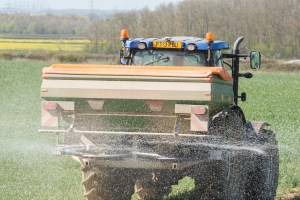
On Andrew Pitts’ farm, first wheats are targeted at a base rate of around 160kgN/ha, and second wheats at 180-200kgN/ha, but that will vary from field to field depending on soil N-Min tests taken in early February and crop requirements.
The farm standard for a first wheat grown for seed used to be 200-220kgN/ha, plus another 40kgN/ha for second wheats, he explains. “But, through our Helix work, we’ve consistently seen that 160kgN/ha is our optimum for first wheats. If we use any more, we’re not utilising it effectively.
“My view now is that, particularly with fertiliser at £2+ per unit of nitrogen, first wheats will be targeted at a base rate of around 160kgN/ha, and second wheats at 180-200kgN/ha, but that will vary from field to field depending on soil N-Min tests taken in early February and crop requirements. We’re using less overall, and instead of two or three applications, it’ll be four or five.”
He believes the savings outweigh any extra application cost. “Using 40kgN/ha less product is a £80/ha saving. Travelling once more with the spreader or the sprayer, costs roughly £12-14/ha application cost, which still leaves £65/ha less spent.”
He’s also about to convert from 24m to 36m tramlines following the purchase of a new 8000-litre sprayer, so “getting around the farm is not going to be a problem”.
“Furthermore, because of the Helix work we’ve been doing on crop and soil management, we’re up at 75-80% NUE, which is terrific,” he says.
Soil Mineral Nitrogen (SMN) testing of the same fields over multiple seasons provides a good benchmark for residual nitrogen and builds a useful database to analyse changes after different crops or agronomic practices, adds Andrew.
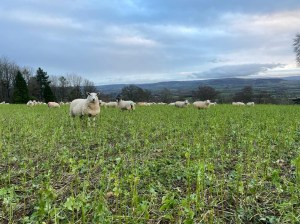
Andrew Pitts has consistently seen 50-100kgN/ha after overwintered stubble turnips and grazing over the past three or four years.
Wheats typically receive their first application as solid ammonium nitrate as soon as conditions allow in February before switching to liquid products containing sulphur for the second and third applications, then back to AN for the fourth dose.
Tissue testing of the flag leaf is a valuable tool for determining whether extra foliar nitrogen is required on the ear for milling wheats to meet grain protein requirements, he notes.
“We’ve been using Hillcourt Farm’s protein prediction for several years and it’s been very accurate. It’s a simple test that doesn’t cost a lot. We’ve definitely made more profit doing the test than not. That’s the ultimate measure for any of these tools or techniques; does it deliver a higher gross margin? If the answer’s yes, we’ll do it again.”
At Helix East in Suffolk, Tom Jewers also recognises the value of accurate soil and tissue testing for refining his fertiliser strategy.
He usually starts by calculating the breakeven ratio in Omnia, based on information such as nitrogen cost, historic average yields and budgeted crop price. “There’s also a useful breakeven tool on the AHDB website that I’ve used previously.”

Tom Jewers highlights the pattern of recent dry springs where the benefit from soil-applied fertilizer may not be seen, so he’s been trialing replacing it with foliar N.
For this season, breakeven figures recommend reducing rates by 25kgN/ha due to the risk/reward ratio. This recommendation is fine-tuned with N-Min results, which in February showed Soil Nitrogen Supply (SNS) of 112-151kgN/ha.
Tom acknowledges he was initially cautious about cutting fertiliser rates too far based on N-Min analysis, however confidence in the results is growing. “We’ll monitor things with tissue tests as we go through the season, but I’m much happier with N-Mins now than in the past.”
Tom’s wheats typically receive two initial doses of 60kgN/ha each (120kgN/ha total) granular nitrogen/sulphur fertiliser (27% N + 9% SO3). Then depending on conditions, he either applies a 33.5% N granular fertiliser, or if very dry, instead he’ll use two, three or four foliar applications of Azotica 33 or Aiva Foliar N.
“With the pattern of recent dry springs, we might not get the benefit from soil-applied fertiliser, in which case I’ll try replacing it with foliar N. I’m not 100% convinced yet, but my confidence is growing that we’re getting the response from foliar applications where we’re putting less soil-applied N on.”
Like Andrew, nitrogen response trials at Helix East show yield typically plateaus beyond 160kgN/ha. “If you put 160kgN/ha of soil-applied N on, you’re already at the top of the response curve, so if you start putting more on as a foliar treatment, you’re unlikely to see the benefit when trying to measure it coming off the combine.
“It’s easier to see a response if we start from a lower base of 120-130kgN/ha, then switch to foliar.”
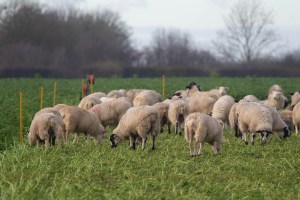
N-Min sampling after a cover crop (clover, vetch, phacelia, linseed, buckwheat mix) has returned 80-100kgN/ha, plus another 20kgN/ha where cover was grazed by sheep.
Tom recognises foliar N is only a top-up to a solid foundation of soil nutrition and warns it won’t build crop biomass. A tramline trial where soil-applied N was reduced to 80kgN/ha clearly demonstrated this. “The crop itself, according to tissue samples, was never short of nitrogen, but that’s only because less nitrogen was being shared between fewer plants.”
In contrast, the foliar top-up was more effective with a base application of 120kgN/ha. “Each farm is different, so it’s about finding what level works in your situation.”
Hutchinsons’ fertiliser and crop nutrition specialist Rob Jewers says similar results are seen in trials elsewhere. “Where insufficient base fertiliser was applied, the foliar N couldn’t make up the difference. It does vary though; on some farms it might be 120 or 140kgN/ha, while on another it could be 180kgN/ha.
“If the base level isn’t there, you’re not building the biomass, or generating and retaining the tillers. Also, if it’s a thin crop with less leaf area to take up foliar fertiliser, some will be hitting the soil, which is very inefficient.”
Tom also says many other nutrients, such as iron, molybdenum, and manganese, need to be optimised for plants to utilise nitrogen and other macronutrients efficiently. In-season tissue testing is useful for identifying potential deficiencies. He does an initial test in February/early March, then every fortnight on representative fields to monitor crop progress.
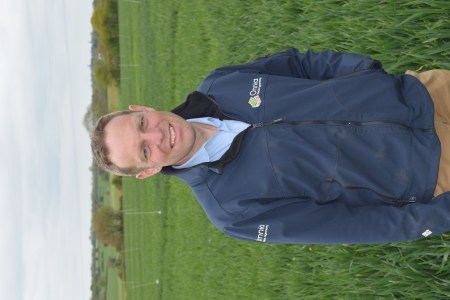
In trials, where insufficient base fertiliser was applied, the foliar N couldn’t make up the difference, highlights Rob Jewers, though the level of base fertiliser needed is very variable.
“We’ve tried sap testing, which tells us a lot more, but gathering samples is very labour intensive. The Holy Grail is some kind of handheld device you can clip onto leaves to give real-time information about the crop’s nutrient status.”
Andrew agrees. “The growing window for wheat is actually really short, with the bulk happening between 1 March and June, giving 8-12 weeks to make a big difference. If there’s something wrong, you need to correct it quickly.”
Tom and Andrew recognise healthy soil drives the efficiency with which nutrients are cycled, accessed and utilised by plants, and retained – rather than being lost through leaching or denitrification.
“I’m sure our predominantly chalky boulder clay soils have become more efficient at using nitrogen because we haven’t cultivated for years,” says Andrew. “We’ve been direct drilling for 6-7 years and using very shallow min-till before that.”
Crop residues are all chopped to build soil organic matter, while cover crops are integral to the rotation, feeding soil biology, building structure and drainage, and enhancing fertility.
Tom has also been direct drilling since 2016 and says good soil management is key to achieving strong, even plant establishment, which sets the foundation for using nutrients efficiently.
Andrew agrees. “Once you’re several years into direct drilling and the soil’s got used to it, you’re able to establish more even plant stands.
“Direct drilling conserves moisture and allows more even germination, particularly in spring crops, when instead of letting soil dry out at depth, you only have to wait until the surface is dry enough to carry a tractor on low pressure tyres. We’ve seen beans and spring barley fly out of the ground because moisture hasn’t been lost creating a seedbed.”
They both think variable seed rates are important for establishing even crops, perhaps more so than variable rate nitrogen.
“If you’ve got low biomass areas, increasing seed rates seems more effective at overcoming that than simply applying more nitrogen,” says Tom. “We’ve never been able to manipulate a biomass map just using variable rate nitrogen.”
He still thinks variable rate nitrogen has a place and uses Omnia to generate application plans based primarily on variations in yield potential (using historic mapping data) and satellite imagery. “I’ve never been entirely convinced we’re getting the right response by just basing decisions on biomass. The aim is to concentrate our inputs where we’re going to get maximum return,” he adds.
Andrew has tried different approaches to variable rate nitrogen but admits the “jury’s still out” on its effectiveness. “I’m yet to be convinced, whereas I’d never drill without variable rate seed. If you can establish a more even crop, there’s less need to vary nitrogen.”
While Andrew admits to initially being sceptical about cover cropping, he has seen real value over the past 5-6 years. “We’ve always seen a nitrogen benefit, with significantly higher N-min after cover crops than without. If cover is grazed, it’s even higher.”
N-Min sampling in a second cereal situation – spring barley after wheat, for example – typically shows 30-50kgN/ha in the soil. But N-Min sampling after a cover crop (clover, vetch, phacelia, linseed, buckwheat mix) has returned 80-100kgN/ha, plus another 20kgN/ha where cover was grazed by sheep, says Andrew.
“Over three or four years of cover cropping, we’ve consistently seen 50-100kgN/ha after overwintered stubble turnips and grazing. Last year, in one field going into spring barley we found 140kg/ha of available nitrate in the spring after a dry winter and a really good crop of stubble turnips grazed by sheep. The barley received 30kgN/ha applied as ammonium sulphate and yielded surprisingly well.”
Andrew was so convinced by cover and catch cropping that last year he fitted an auto-caster to the combine to establish cover between every crop.
“Unfortunately, the summer was so dry we didn’t use it. The only cover we established was 40ha of stubble turnips, direct drilled after rain in September, which will go into vining peas for seed. Where we’ve grown peas after stubble turnips before they’ve produced a phenomenal crop, so hopefully the extra nitrogen will help crops grow tall enough to go through the combine.
“I’ve gone from being sceptical about cover crops, to thinking absolutely no way would I not plant them now given sufficient moisture. Quantifying financial returns is hard, but we’ve certainly seen clear benefits to nutrition and soil health.”
Tom also believes cover crops bring big benefits, not least in preventing nitrogen leaching during wetter autumn and winter months. He acknowledges quantifying residual nitrogen benefits is hard though.
“It may be because we’ve used them for quite a while now, so the soil is just cycling nutrients differently. Until last year, the only thing we hadn’t done is graze cover crops off, so it’ll be interesting to see if that makes a difference to N-Min.”
This article was taken from the latest issue of CPM. For more articles like this, subscribe here.
Sign up for Crop Production Magazine’s FREE e-newsletter here.

